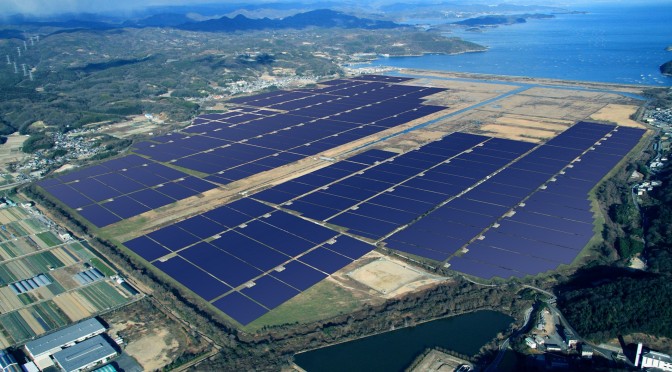Japan, an industrialized country but extremely resource poor, has put a great deal of attention on developing new and renewable energy over the years, with the latest case being in Okayama Prefecture where the construction of the biggest solar power plant was launched on Friday.
A total of 920,000 solar panels will be installed at the super 230-megawatt plant that will eventually span a 265-hectare area in the prefecture’s Setouchi city in western Japan, with its cost reaching about 110 billion yen (about 956.5 million U.S. dollars).
The project is slated to be finished in 2018 and is expected to be operational in the first half of 2019, according to local reports.
Data from Japan’s Industry Ministry said in 2013, newly installed solar power generating capacity surged 150 percent from a year earlier to 5,000 megawatts, ranking Japan as the world’s second-largest solar power producer after China.
Separated data from the ministry also showed that solar power generating capacity by ministry-approved equipment in February 2013 stood at about 39 gigawatts and the reading skyrocketed to 68 gigawatts by March 2014 in the island country.
The significant achievements can be partially attributed to the Japanese government which launched a series of systems to encourage the development of the new energy industry.
The nation introduced in 2012 a government purchase system, which stipulated that the government bear the responsibility to purchase electricity generated by ministry-approved solar power equipment with a fixed price and some other governmental subsidies.
It also carried out an enterprises exemption system which sees funds invested in renewable energy recognized as operating costs and are exempt from income tax.
Having such supportive policies, Japanese enterprises, such as Orix, Sharp, Mitsubishi Electric and Softbank, are encouraged to march forward in the industry.
Besides the solar power plants, Japan is also pushing forward the construction of solar powered houses that use solar panels as roofs to provide electricity and such kind of dwelling could receive about 450,000 yen (about 3,926 dollars) in governmental subsidies, as well as other local governmental assistance.
For Japan, nuclear power was important to address its energy shortage, but after the Fukushima Daiichi nuclear power plant crisis in March 2011, all commercial nuclear reactors of the country are offline right now.
Even if all of them are put back online, the reactors could only generate 19.5 percent of Japan’s energy supply.
As the first reconstruction project in the tsunami-hit Fukushima Prefecture, the Industry Ministry has decided to build floating offshore wind turbines in the prefecture and eyes making the world’s largest wind farm, which could generate about 1,000 megawatt/hour of electricity and create 4,000 jobs.
The floating wind turbines have been operational since last November.
According to the Japan Wind Power Association, the island country that has a pretty long coast, has about 144-gigawatt onshore wind energy and 608-gigawatt offshore wind energy reserves that can be explored, with Japan now researching large generator sets that can be built on different terrain or wind conditions.
Bio-energy is also an important field for Japan to develop to help address its energy shortage. As many countries use grain crops such as corn and soybean to create alcohol and gasoline, Japan, however, uses non-grain materials to develop bio-fuel as parts of the world is still suffering from severe food shortage.
Now, Japan focuses on using hydrocarbon in microalgae that could be easily bred, even in life or agriculture wastewater.
According to University of Tsukuba, dried microalgae contain up to 20 to 30 percent of hydrocarbon and the reproduction of such microalgae can absorb an abundance of green gas such as carbon dioxide from the air.
Bio-fuel made by such microalgae has been used in some buses in Japan in July this year and the fuel that was extracted from this kind of microalgae named Gracilis may be used in aircraft fuel in the near future.
Universities and airline companies in Japan have formed a panel on developing next generation aircraft fuel, aiming at increasing the portion of bio-fuel used in aircrafts to about 10 percent by 2020, with experts forecasting that the cost of such bio-fuel would decrease to about 200 yen (about 1.75 dollars) per liter by the same year.
According to a Japan’s white paper on energy, the generating capacity of power plants that use bio-fuel stood at 2,300 megawatts as of June 2012 and the number increased by 847 megawatts as of February from July 2012.
According to a report by Fuji Keizai, bio-fuel market sees a fast growing era in Japan and the market scale is expected to hit 176.6 billion yen (about 1.54 billion dollars) by 2015.
It also pointed out that with the development of bio-fuel technology, decreased costs and increased attention on the environment, the portion of renewable bio-fuel in energy consumption will jump greatly.



